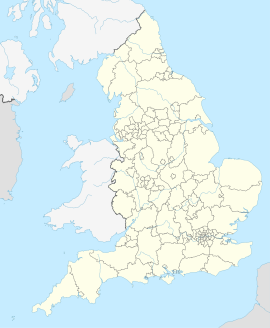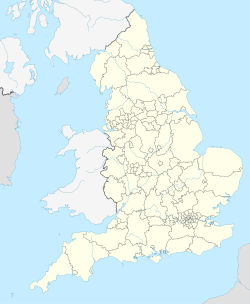St Helens (Merseyside)
| St Helens | ||
|---|---|---|
(c) Cathie Garner, CC BY-SA 2.0 | ||
| Staat: | ||
| Koordinaten | 53° 27′ N, 2° 45′ W | |
| OS National Grid | SJ505955 | |
| ||
| Traditionelle Grafschaft | Lancashire | |
| Einwohner | 102.629 (2001 Census) | |
| Verwaltung | ||
| Post town | ST. HELENS | |
| Postleitzahlenabschnitt | WA11, WA10, WA9, L35, WN4, WN5 | |
| Vorwahl | 01744 | |
| Landesteil | England | |
| Region | North West England | |
| Metropolitan county | Merseyside | |
| Metropolitan Borough | St Helens | |
| Britisches Parlament | St Helens North St Helens South and Whiston | |
St Helens ist eine Stadt mit 106.100 Einwohnern (Stand 1. Januar 2004) in North West England, Vereinigtes Königreich. Sie liegt zwischen Manchester und Liverpool im Metropolitan County Merseyside und ist der namensgebende Kernort des größeren Metropolitan Borough of St Helens, der weitere umliegende Städte umfasst.
Geschichte
Die Stadt wurde 1552 das erste Mal erwähnt und hat ihren Namen von der dort befindlichen Kapelle bekommen. Sie war im 16. Jahrhundert ein Zentrum der Kohleförderung und seit dem 18. Jahrhundert Mittelpunkt der Glasherstellung in Großbritannien.
Seit im Jahre 1762 der Kanal „Sankey Navigation“ zwischen St Helens und River Mersey eröffnet wurde, entwickelte sich die Stadt zu einem Industriezentrum der Region mit einer schnell wachsenden Einwohnerzahl.
Sehenswürdigkeiten
Sehenswert ist der 1830 erbaute Sankey Viaduct an der am 15. September 1830 eröffneten Eisenbahnlinie von Liverpool nach Manchester. Hier testete George Stephenson (1781–1848) seine Lokomotive The Rocket.
In der Nähe befinden sich ein bei Einheimischen und Touristen beliebter Safari-Park sowie die Haydock-Park-Rennbahn.
Wirtschaft
Saint Helens ist eine Industriestadt (vor allem Glas- und chemische Industrie). Dort hat einer der weltgrößten Glashersteller und Hauptarbeitgeber der Region, Pilkington Glass, seinen Firmensitz.
Ein bekanntes Produkt aus St. Helens waren außerdem Beechamʼs Pills, ein Abführmittel aus Ingwer und Seife, die in der gleichnamigen Fabrik von 1842 bis 1998 – also über 150 Jahre lang – produziert worden waren.[1]
Sport
Beim lokalen Fußballklub St Helens Town AFC spielte in den frühen 1950er Jahren Bernd Trautmann als Torwart, ehe er zu Manchester City wechselte.
Söhne und Töchter der Stadt
- Evelyn Jamison (1877–1972), Mittelalterhistorikerin
- Thomas Beecham (1879–1961), Orchesterdirigent
- Tommy Lucas (1895–1953), Fußballspieler
- Herbert Mundin (1897–1939), Schauspieler
- Geoff Duke (1923–2015), Motorradrennfahrer
- Bill Foulkes (1932–2013), Fußballspieler und -trainer
- John Connelly (1938–2012), Fußballspieler
- Peter Clarke (* 1957), Schlagzeuger
- Terrence Tinsley (* 1957), Radrennfahrer
- David Yates (* 1963), Regisseur und Drehbuchautor
- Alan Tabern (* 1966), Dartspieler
- Nick McCabe (* 1971), Elektro-Musiker, Gitarrist und Musik-Produzent
- Johnny Vegas (* 1971), Schauspieler
- Una McCormack (* 1972), Schriftstellerin
- Jacqui Abbott (* 1973), Sängerin
- Lee Briers (* 1978), Rugby-League-Spieler
- Dave Chisnall (* 1980), Dartspieler
- Emma Rigby (* 1989), Schauspielerin
- Michael Smith (* 1990), Dartspieler und Darts-Weltmeister 2023
Partnerstädte
Deutschland
Frankreich
Weblinks
Einzelnachweise
- ↑ Best for Me, Best For You'—A History of Beecham's Pills 1842–1998. In: The Pharmaceutical Journal. Nr. 269, S. 921–924.
- ↑ Stuttgarts Partnerstädte. stuttgart.de, abgerufen am 11. Juli 2021.
- ↑ British Towns Twinned with French Towns. completefrance.com, abgerufen am 11. Juli 2021 (englisch).
Auf dieser Seite verwendete Medien
Flagge des Vereinigten Königreichs in der Proportion 3:5, ausschließlich an Land verwendet. Auf See beträgt das richtige Verhältnis 1:2.
Flagge des Vereinigten Königreichs in der Proportion 3:5, ausschließlich an Land verwendet. Auf See beträgt das richtige Verhältnis 1:2.
(c) Karte: NordNordWest, Lizenz: Creative Commons by-sa-3.0 de
Positionskarte von England, Vereinigtes Königreich
(c) Cathie Garner, CC BY-SA 2.0
A photo montage using a mix of archive historical images, and current town depictions
Creative Commons License
| Beschreibung | St Helens Victoria Square, depicting Town Hall and Gamble Institute |
| Datum | (UTC) |
| Quelle | https://www.google.co.uk/search?q=jimmy+savile&client=ms-android-samsung&prmd=inv&sxsrf=ALeKk00qVI6g0ALMbKmO2XR5rp_1Ul0Gag:1603138555287&source=lnms&tbm=isch&sa=X&ved=2ahUKEwjz6vPAvMHsAhW1uXEKHXCcAB0Q_AUoAXoECAcQAQ&biw=360&bih=577&dpr=3#imgrc=yg9kFmWzNHD-2M |
| Urheber | Cathie Garner https://www.geograph.org.uk/profile/42334 |
| Genehmigung (Weiternutzung dieser Datei) |
Creative Common License, and Public Domain - see below. |
"This is a view of Victoria Square in St Helens, Merseyside. On the left hand side can be seen the Town Hall with the clock tower, and directly across from the photographer is the Gamble Institute which houses the Central Library. The statue of Queen Victoria which used to stand in the middle of the square has now been moved to just behind where the photo is taken from."
| Beschreibung | The Anderton Shearer monument located in St. Helens |
| Datum | (UTC) |
| Quelle | https://www.geograph.org.uk/photo/1532332 |
| Urheber | Galatas https://www.geograph.org.uk/profile/22875 |
| Genehmigung (Weiternutzung dieser Datei) |
Creative Common License, and Public Domain - see below. |
"This monument to Mr. Anderton, the inventor of the power shearer and loader, otherwise known locally as "th'cutter", which revolutionised longwall mining throughout the world.You can see the helical drum of the cutter under the bust of a collier. Each pick in the drum had a manganese-steel tip and each pick was worth £27 over 25 years ago.Originally the monument was situated in front of Anderton House, Lowton, which place housed National Coal Board district administrative offices; with the closure of these offices together with that of the last colliery in the Lancashire coalfield, the monument was moved to National Coal Board (renamed British Coal) Western Area offices in Stoke-on-Trent, Staffordshire. However, as the Anderton shearer was first used at Ravenhead Colliery ("Groves's"), St. Helens, of which colliery Mr. Anderton was the general manager, St. Helens council asked British Coal if they could transfer the monument to a site which is very near to where Ravenhead colliery used to be. One more point (and don't tell anybody): Mr. Anderton was a Wiganer. There is often confusion between James Anderton CBE , former chief constable of Manchester who was born in Wigan , and James Anderton OBE , inventor of the power shearer , whose birthplace I have so far been unable to confirm. However he lived locally and died aged 89 at his home in Newton le Willows."
| Beschreibung | St Mary's Lowe House |
| Datum | 16:15, 1 July 2010 (UTC) |
| Quelle | https://www.geograph.org.uk/photo/511032 |
| Urheber | Sue Adair https://www.geograph.org.uk/profile/1657 |
| Genehmigung (Weiternutzung dieser Datei) |
Creative Common License, and Public Domain - see below. |
"The impressive St Mary’s Lowe House, dubbed “The Poor Man’s Cathedral”, was built using money collected from working class people during the depression. The land on which the present church stands, was donated in 1793 by the widow of John Gorsuch Eccleston of Eccleston Hall (her maiden name was Lowe). The chapel was replaced with the current building, the tower and dome of which dominate the skyline of St Helens." Public Domain Ravenhead Mine Works - Public Domain, St Helens Library Archives
Casting Hall, British Plate Glass Co. Ravenhead - Public Domain, St. Helens Library Archives



